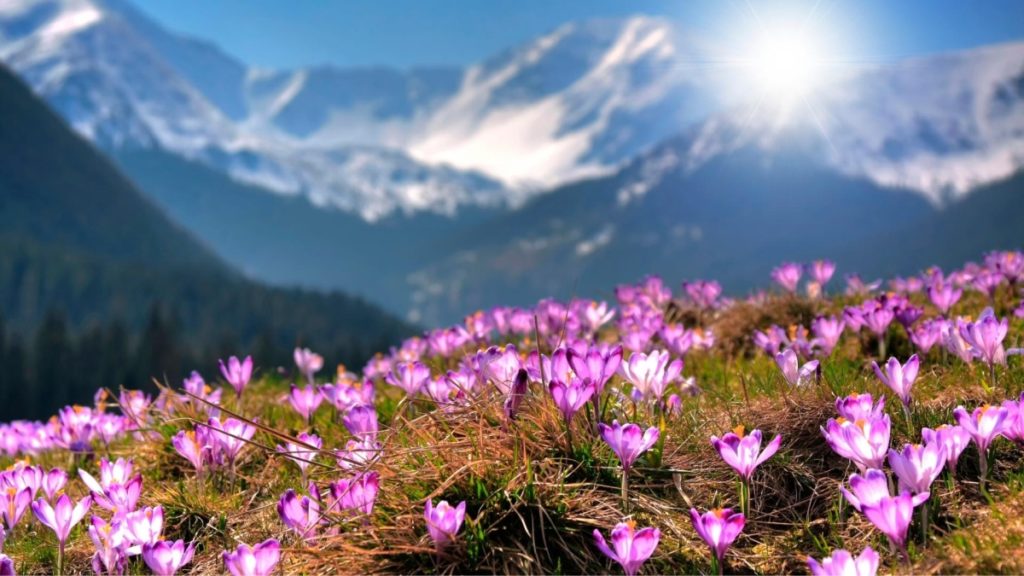
Flowers add beauty and bring our yard and gardens to life. Your gardens of the mountains and basins are no different. Native plants can vary in the mountains and basins. The basins are dominated by grasslands and shrubs Where as mountain slopes are clothed in open forests of conifers and deciduous trees.
Spring brings a grand display of nature’s colors in the lowlands, while summer is the peak season at higher elevations. The growing season shortens as the elevation increases. At mid elevations, your mountain gardens might be blessed with Quaking aspen (Popululs tremuloides), or an open canopy of Ponderosa pine (Pinus ponderosa). Your trees may be filled with birds that favor the pine nuts.
Near the base your gardens are filled with Rocky Mountain columbine (Aquilegia caerulea). These blue flowers are popular with hummingbirds.
Where ever the ground has been disrupted or fires have been, you are sure to see loose spikes of Fireweed (Epilobiom angustifolium) throughout the area alive with bees and butterflies seeking nectar.
On dry, sunny slopes you may have Beardlip penstemon (Penstemon barbatus) and the Cardinal penstemon (P. cardinalis) attracting hummingbirds as do the biennial Gilia (Ipomopsis aggregata).
Close to your house your choice of flowers may be Gaillardiaand some White yarrow (Achillia millefolium) full of butterflies. Maybe wild lupines or various heucheras fill your landscape.
Native flowers of the mountains and basins will draw non stop action to your gardens. Attract various hummingbirds during the seasons. Your gardens will become home to butterflies as you plant nectar producers and host plants. Song birds will hang out year round as they enjoy the surroundings. Small mammals are a given.
As I do research for these pages, I am so amazed at the diverse habitats we have in North America. Not only the plant and animal life, but weather related hardships and more. How tough the people must be and are, as well as nature. I can’t give a description of every plant in your region, but here are some ideas to native plants that and a good start to any garden of the mountains and basins.
Northern Mule’s Ears (Wyethia amplexicaulis)
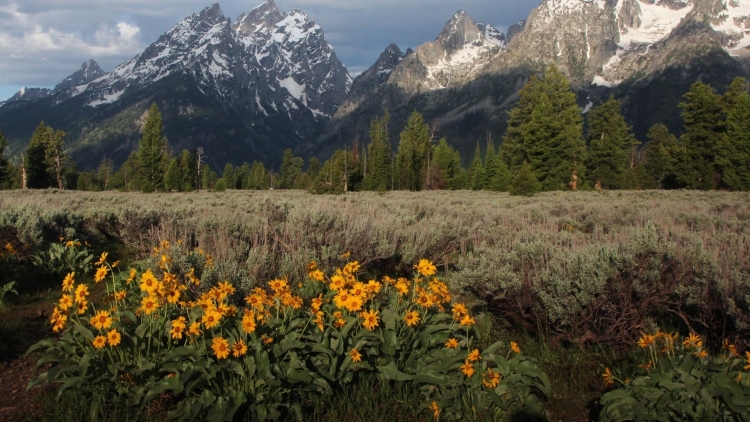
Habitat Open hillsides and meadows, open woods, from foothills to moderate elevations in mountains
- Family: Asteraceae
- Fruit: seed-like, narrow, 4-sided, with a low crown of scales at top.
- Zone: Hardy in zones 5 to 9
- Range: Central Washington to western Montana; south to northwestern Colorado, northern Utah, and Nevada.
- Height: 12-32″ (30-80 cm).
- Blooms: July to August
- Flowers: yellow blooms with a central head 3-5″ (7.5-12.5 cm) wide, with lanceolate bracts that often extend past top of disk; about 13-21 rays and scales enfold bases of disk flowers.
- Leaves: those at base 8-24″ (20-60 cm) long, with lanceolate blades on short stalks; those on stem smaller, their bases wrapped partly around the stem.
General Culture
Plant seems varnished with resin, the stout leafy stems growing from clumps of lanceolate leaves, ending in several large deep yellow flower heads on long stalks, the central head largest.
The plant prefers light (sandy) and medium (loamy) soils and requires well-drained soil. The plant prefers acid, neutral and basic (alkaline) soils. It cannot grow in the shade. It requires moist soil.
Attracts butterflies, bees and birds.
Heartleaf Arnica (Arnica cordifolia)
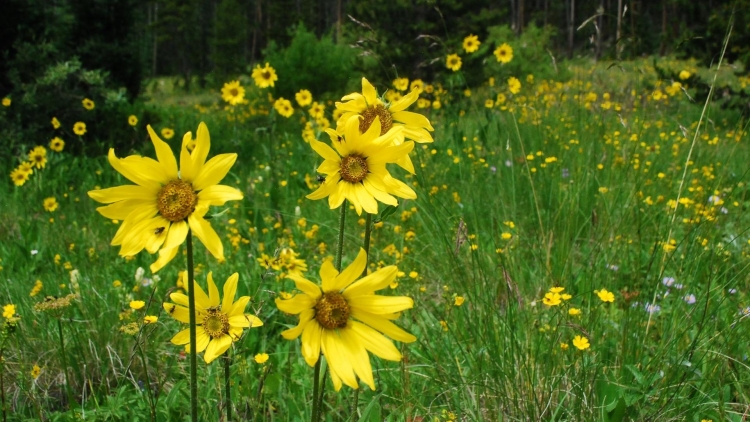
In alpine areas or in open places along roads, the leaves may be narrower and without the notch at the base of the blade. All western species have paired leaves on the stems, but only this one has heart-shaped leaves.
- Family: Asteraceae
- Zone: Hardy in zones 2 to 9
- Blooms: April-June, occasionally to September.
- Flowers: heads 2-3 1/2″ (5-8.8 cm) wide; with 10-15 rays each and many tiny disk flowers; bracts of head have long spreading hairs.
- Range: From Alaska to southern California; east to the Rocky Mountains from Canada to New Mexico; also in northern Michigan.
- Leaves: those on separate, short shoots largest, 1 1/2-5″ (3.8-12.5 cm) long, with long petioles attached at notch; those on flowering stem with short or no petioles.
- Fruit: seed-like, with a tuft of white or pale tan hairs at top.
- Height: 4-24″ (10-60 cm) tall.
- Cultivation: Prefers a moist, well-drained humus rich soil, preferably lime-free. Prefers a mixture of sand, loam and peat
- Sun sun to partial shade
General Culture
Stems with 2-4 pairs of heart-shaped leaves are topped by 1-3 broad yellow heads. Plants in patches. Habitat In lightly shaded woods. Toxic.
Attracts birds, butterflies, and other pollinators.
Ipomopsis aggregata (Gilia aggregata)
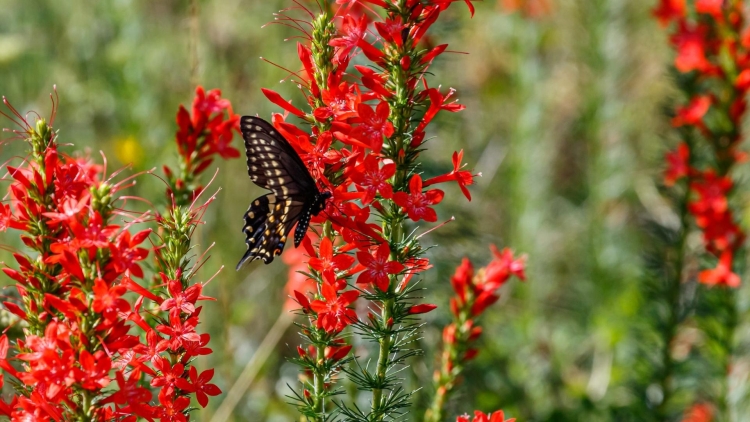
Description In upper leaf axils and at tops of sparsely-leaved stems are clusters of showy, bright red or deep pink, trumpet-shaped flowers. Habitat Dry slopes from sagebrush to forest.
- Common name: Scarlet Gilia, Scarlet Skyrocket, Skunk Flower
- Family: Polemoniaceae
- Zone: Zone hardy 3 to 8
- Flowers: May-September
- Flowers: corollas 3/4-1 1/4″ (2-3.1 cm) long, with 5 pointed lobes. Red and orange.
- Leaves: mostly 1-2″ (2.5-5 cm) long, densest near base, pinnately divided into narrow segments.
- Height: 6-84″ (15-210 cm).
- Range: Most of the West and Southwest.
General Culture
One of the most common western wildflowers, grows readily from seed; its brilliant red trumpets are handsome in the native garden.
Its beauty compensates for the faint skunky smell of its glandular foliage, responsible for the less complimentary name Skunk Flower.
Though a biennial, this stalwart plant deserves a place in your wildlife gardens.
Aquilegia caerulea (Blue columbine)
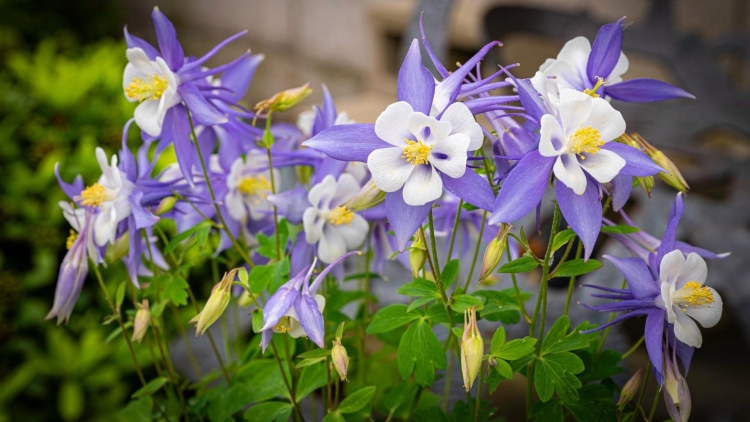
It tolerates wide range of soils except heavy, poorly drained ones. Prefers rich, moist soils with light to moderate shade.
- Common Name: Rocky mountain columbine
- Family: Ranunculaceae
- Zone: Hardy in zones 3 to 10
- Native Range: Western United States
- Height: 1 to 2 feet
- Spread: 1 to 2 feet
- Bloom Time: April – May
- Bloom Color: Blue & white
- Sun: Full sun to part shade
- Water: Medium, to much water causes crown rot.
- Maintenance: Medium
General Culture
Easily grown in average, medium, well-drained soil in full sun to part shade.
Remove spent stems after bloom to encourage additional bloom. Keep soils uniformly moist after bloom to prolong attractive foliage appearance.
This species may be grown from seed and may self-seed in the garden under optimum growing conditions.
Noteworthy Characteristics
Rocky Mountain columbine is a bushy, clump-forming perennial which occurs in the U.S. Rocky Mountains at elevations of 6000 to 12000′ from Montana south to New Mexico.
In cultivation, it typically grows 1.5-2′ tall and features large, upward-facing, bicolored flowers (to 3″ across) with 5 pale to sky blue sepals and 5 white petals with backward-extending, straight and slender blue spurs (to 2″ long). Blooms in spring.
Problems
No serious insect or disease problems. Foliage usually declines by early to mid-summer at which point it should be cut to the ground.
Uses
Borders, cottage gardens, open shade gardens, native plant gardens or naturalized areas. Attracts hummingbirds, bees and seeds will attract small birds.
Gaillardia aristata (Blanket flower)
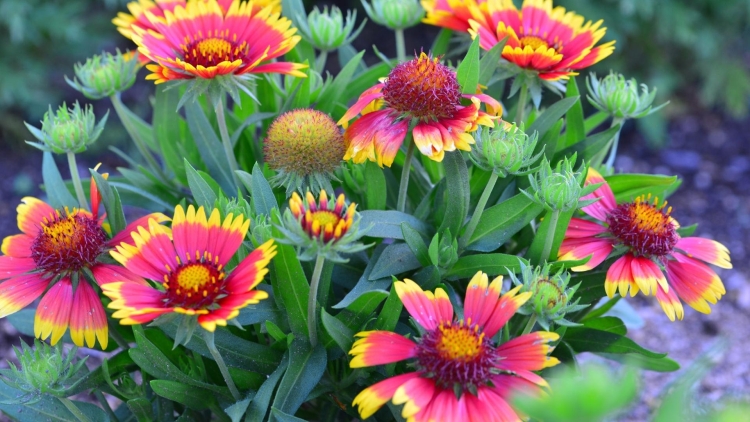
Easily grown in average, dry to medium, well-drained soils in full sun. Prefers moist, organically rich soils that drain well but tolerates dry soils and drought.
- Common Name: blanket flower.
- Zone: hardy from 3 to 8.
- Family: Asteraceae.
- Native Range: Most of the western half of the United States and southern Canada.
- Height: from 6 inches to 30 inches.
- Spread: 0.75 to 2 foot.
- Bloom Time: May – to killing frost.
- Bloom Color: Orange-red some cultivars are yellow or burgundy.
- Sun: Full sun.
- Water: Dry to medium.
- Maintenance: Low.
General Culture
Performs poorly in unamended, heavy clay soils.
Deadheading spent blooms is not necessary, but will tidy the planting and may encourage additional bloom.
If flowering declines or stops in summer, consider cutting back plants to encourage a fall bloom.
Noteworthy Characteristics
Gaillardia aristata is a species that is native from North Dakota to Colorado west to California and British Columbia.
It typically grows in clumps to 30” tall and is found primarily in dry sites on meadows, prairies, grasslands, mountain foothills and at lower mountain elevations to 9000’.
Blooms late spring to fall. Lance-shaped gray-green leaves may be pinnately lobed near the base of the plant.
Attractive to butterflies. In areas where goldfinches are present, gardeners should consider leaving some spent heads for the birds.
Gaillardia is sometimes commonly called blanket flower in probable reference to the resemblance of its rich and warm colors and patterns to blankets woven by Native Americans. However, some authorities suggest that the name was originally derived from the habit of wild species plants to form colonies that blanket the ground.
Problems
No serious insect or disease problems. Root rot may occur in poorly drained soils, particularly during periods of protracted heavy summer rains. Species plants are generally susceptible to powdery mildew, aster yellows and fungal leaf spot diseases.
Uses
Perennial border fronts, rock gardens, cottage gardens and cutting gardens. Also effective in containers.
Feed heavy for constant bloom.
Agastache cana (Hyssop)
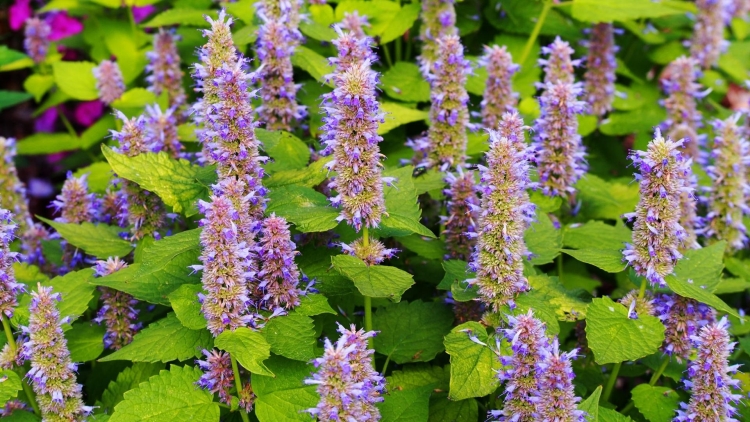
Easily grown in average, dry to medium, well-drained soils in full sun to part shade. Best in full sun. Also tolerates drought and poor soils.
- Common Name: giant hyssop
- Zone: hardy in zones 5 to 9
- Family: Lamiaceae
- Native Range: Western half of the United States, British Columbia into Alaska
- Height: 3 feet
- Spread: 1 to 3 feet.
- Bloom Time: June – September
- Bloom Color: pinkish red
- Sun: Full sun to part shade
- Water: Dry to medium
- Maintenance: Low
General Culture
Somewhat tolerant of summer heat and humidity. Non-invasive.
Noteworthy Characteristics
features tubular, sweetly fragrant, pinkish red flowers arranged in whorls on erect, salvia-like, terminal and axillary spikes.
Flowers appear over a long June to September bloom period.
Sometimes it is called mosquito plant because rubbing the aromatic foliage on one’s skin reportedly repels mosquitoes.
Leaves may be used fresh or dried to flavor teas. Agastache comes from the Greek words for “much” (agan) and “grain stalk” (stachys) in reference to the flower spikes. Flowers are attractive to bees and butterflies and hummingbirds.
Problems
No serious insect or disease problems.
Uses
In rock gardens, borders, herb gardens or butterfly gardens.
Attracts hummingbird and other pollinators.
Like most plants in the mint family it is deer and rabbit resistant.
Penstemons
Plant some of the several species of Penstemons in your gardens as well.
- Rocky mountain penstemon is an attractive blue to purple that is as tall.
- Beardlip penstemon has red colored blooms attractive to hummingbirds and grows 3 to 4 feet tall.
- Hardy: in zone 2 to 9
- Penstemons need full sun (Will handle a couple hours of shade) and low humidity.
- Water: Low to moderate.
- There are several native species and cultivars to choose from.
Fireweed (Epilobium angustifolium)

Who can you ignore this almost ubiquitous wildflower as it can be found throughout Canada and most of the United States. Fireweed is one of the first signs of life after a fire or if the earth has been worked as the attractive bloomers pop up soon after.
- Though its moisture needs can be high, it is a tough plant that can’t be ignored.
- Abundant in coniferous forest, mixed forest, aspen parkland, grasslands, and muskeg.
- Declines due to the effects of competing vegetation.
- Progressive changes from open to closed canopy in a forest result in decreasing abundance.
- Fireweed is hardy from zones 2 to 9 and will grow in full sun to full shade.
- It can grow to 5 feet tall and can be invasive as it spreads by seed and rhizomes. However, these plants deserve high praise as they attract hummingbirds, butterflies and other pollinators. Seeds offer food for small birds.
- A prized plant for beekeepers as the nectar rich blooms are a valuable honey plant.
Viguira multiflora (Showy goldeneye)
Grows from 1 to 3 feet tall and is covered with numerous yellow flowers for week during the summer.
- Hardy from zones 3 to 6 Goldeneye grows best in full sun to part shade and is distributed throughout areas of Ponderosa pines.
- A favorite of pollinators, it is also a host plant for sevseveralecies of butterflies.
- Native of the mountains and basins are numerous.
Summary
From Abronia fragrans (sweet sand verbena) and Aster foliaceus (leafy aster),to Iris missouriensis (Rocky Mountain iris, western blue flag) and Thalictrum dasycarpum (tall or purple meadow rue), native flowers deserve a place in your gardens.
Natives are tough, more resistant to nature’s trials and tribulations.
Whether you have them in a natural landscape or cultivated beds, be sure to plant your natives where they will grow their best. All plants have minimal needs. It could be full sun, full shade, dry, moist and even soil conditions. Learn your native plants and flowers and they will reward you for years to come.
Be sure to check out other regions such as Prairies and Deserts, many plants cross regions and indeed the whole continent.
